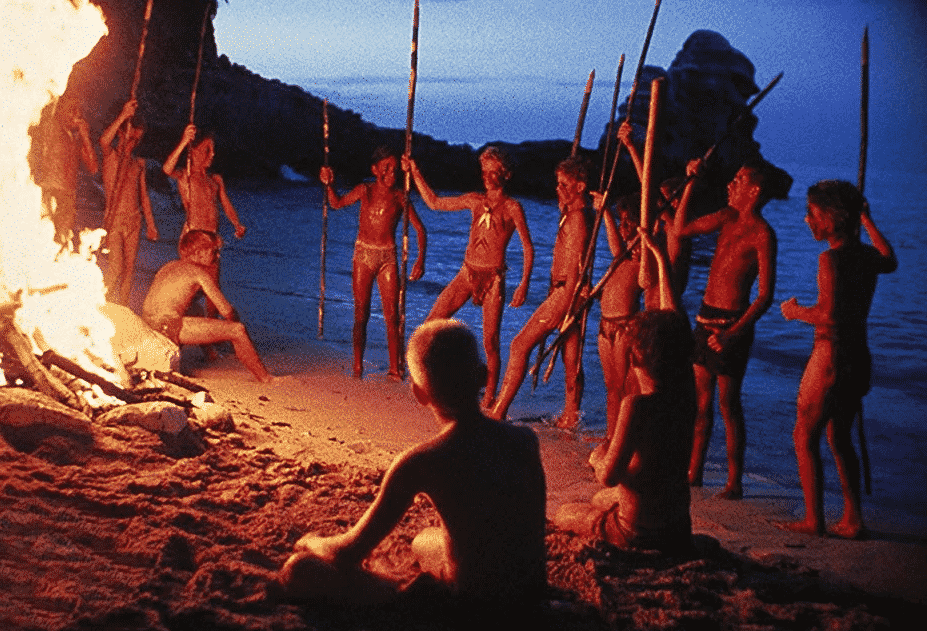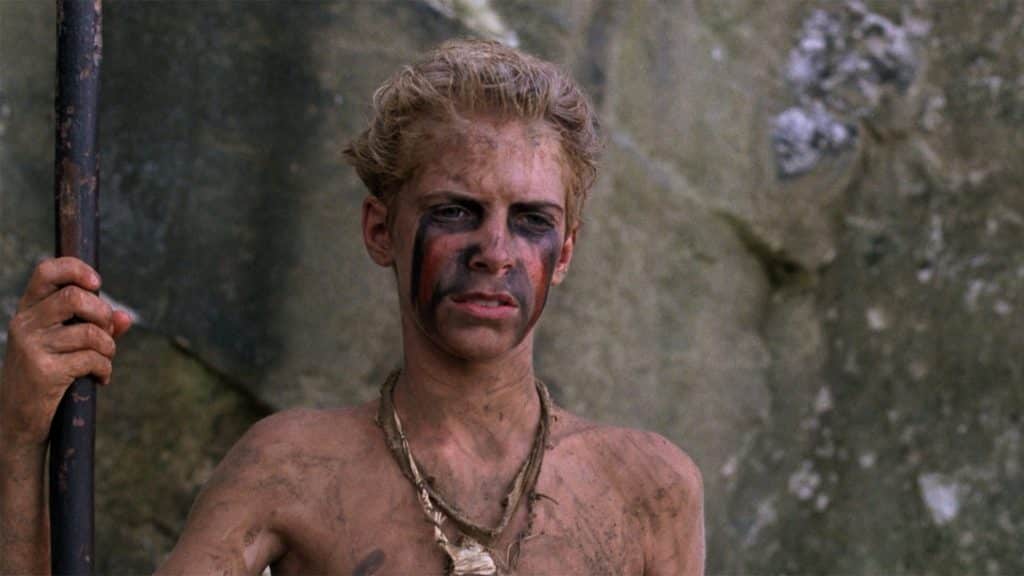“We did everything adults would do. What went wrong (Golding 149)?” questions William Golding’s Lord of the Flies, a novel written exploring and uncovering the dark side of human nature. Symbolism is applied to express the author’s perspective as a lieutenant in the navy during World War II. The conch shell, the war paint, the beast and the lord of the flies fully reveals when the restrictions of human civilization no longer exist, savagery overtakes rationality; leading to brutal acts through the manipulation of fear, and escalates until the inherent evilness of man is uncovered.
A struggle between the need for civilization and the lure of savagery within the nature of man is created in the text. The conflict is presented through the battle between two symbols: the conch shell and war paint. The conch shell was introduced by establishing order and lending a speaker with authority to share his ideas, within the group of British schoolboys. Ralph, who called the first assembly with the powerful sound of the shell, was also given automatic authority and power by it after he suggested that a chief should be determined through a democratic election.
This act of establishing and following orders reveals their needs for civilization as this concept is still ingrained within as part of their superior British value. Although the need is inescapable, civilization didn’t last long under man’s uncontrollable inborn desire to respond to the call of savagery. Ralph understands in chapter nine, that the main reason the boys had gone to Jack’s feast other than their desire for food is “…for hunting and for pretending to be a tribe, and putting on war-paint (Golding 144)”.
The symbolic war paint withdraws the feelings of guilt and shame within the characters, originating from their inner will to commit savage acts that are considered immoral. Unlike some other boys who initially only wore war paint during hunting, Jack wears paint even when he isn’t. The war paint has become an inseparable part of him, concealing morality and his self-consciousness while he is liberated from the restrictions of civilization. Jack’s tribe constantly wearing the paint also signifies the abandoning of civilization to satisfy their evil desires that are formed by their barbaric nature.
During the fight at the castle rock, the death of piggy and the destruction of the shell refers to a complete end of civilization and rationality under the pressure and manipulation of savagery. Piggy’s death scene contains simile, personification and puerile language to remind the reader that these barbarous crimes are committed by children who now are completely enslaved to the lord of the flies and controlled by their vile nature, concealed with the paint. In the end, savagery declares its victory over the now-demolished civilization.
The agitation formed within the group by the beast extracts barbarity which triggered slaughter. The beast is a significant representation which Golding uses to demonstrate the power of manipulation from fear and its role in withdrawing the characters’ brutality. The boys killed a sow that was nursing her young and manipulated its corpse after its death. The pig head after the hunt was gifted as a sacrificial offering to the origin of fear, seeming to be the beast. In actuality, the manipulative origin of their nightmare is the veiled nature – the lord of the flies. By offering the head, the boys are appreciating their inherent evilness that has withdrawn savagery.
The manipulating fear of the beast is also the main cause of the loss of conscience and mortality within the group. While Simon was ready to inform the others of its real form, fear was used by the beast which lives within to bring out savagery and maneuvers the boys; changing Simon from a messenger of truth into a beast who fends off them from fun, causing his death. “At once the crowd surged after it, poured down the rock, leapt on to the beast, screamed, struck, bit, tore. There were no words, and no movements but the tearing of teeth and claws (Golding 118).”
Golding describes the scene by focusing on the moves of the savages, which forms imagery for the reader and stands out the sanguinary of their barbaric acts. The metaphor was also applied for an eerie and maroon atmosphere, forcing the reader to unquenchably link the “tearing of teeth and claws” to the imagery of the beast prior, described by Samneric. This additionally displays the author’s intention of correlating the nature of savagery and the manipulative fear towards a “beast”.
Furthermore, the boys are adopting savagery in order to kill the beast and detach themselves from fear. However, the characters meantime unintentionally eliminates their conscience, represented through the murdering of Simon. An end brought to mortality and conscience frees the boys from its constraints and allows them to fully embrace their dark, bestial nature.
Man’s inherent evilness is uncovered as the vile origin for the end of conscience, logic and escalating savagery. The author embodies the overpowering darkness of human nature through the noteworthy “lord of the flies”, a translation of another name, Beelzebub. The lord of the flies is a representation of the immoral killing of a sow, and the boy’s manipulation of its corpse.
This is an essential act in the text where the boys reach the point of no return, losing their conscience while fully immersed in barbarity. Golding illustrates the hunt in a disturbing way, using language like “the sow fell and the hunters hurled themselves at her (Golding 105).” The word “hurled” indicates the scene as rape and violation, which outstands his intention of creating a terrorizing atmosphere for the reader, making them nauseated by the overpowering savagery as a result of the boys’ brutal nature (Alnajm 101).
Furthermore, Golding specifies the head “A Gift to the Darkness” as the title of chapter eight, signifying its importance in urging the potential evilness in all the boys; which was achieved through the death of the sow that impulses them to a road of no return. In addition, the symbol itself is a demonstration of the escalating brutality without the presence and restrictions of civility.
The conversation between Simon and the lord of the flies also reveals the rooted darkness, existing in all the boys. “And I’m the Beast…Fancy thinking the Beast was something you could hunt and kill…You knew, didn’t you? I’m part of you? I’m the reason why it’s no go? Why things are what they are? (Golding 111)” It is declared that the beast was an imaginary figure, possibly created and believed in purposefully as a reasonable excuse for the boys to committed savage acts as a result of fear towards the beast, all associated with the inescapable, inborn vileness.
Jack’s action of setting off a massive fire over the island in order to kill Ralph in the end, displays how the vileness within has ultimately conquered logic and lead to this irrational decision of endangering the lives of everyone, just to gain all freedom in embracing savagery, without Ralph as an obstacle. The last chapter uncovers the triumph of the dark side that has the tribe controlled by evilness, following Jack uncritically to the very edge of sanity. In the end, the boys fell for violence and were drawn away from civility, reason and mortality under the influence of their innate darkness.
Golding argues the human nature is sinful and vile through its meaningful scenes and symbols which reveals its creation of impulsive savagery and manipulation. It was intentionally written as an allusion to the historical context of World War II as a bitter satire towards the destruction of civilization as the result of one’s inherent vileness. The characters’ long-held beliefs of the British value of civility, collapse at last under the weight of their evil nature. The interrogation toward the abyss discloses, at last, the boundless darkness of humanity.
Works Cited
- Alaa, Lateef Alnajm. “The Main Themes in Lord of the Flies.” International Journal of English and Literature, vol. 6, no. 6, 2015, pp. 98–102., doi:10.5897/ijel2015.0788. Accessed 13th December, 2020.
- Golding, William. Lord of the Flies. Penguin Group, 2016.


